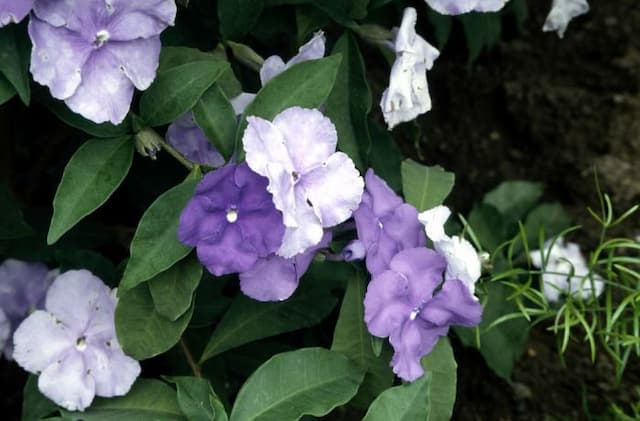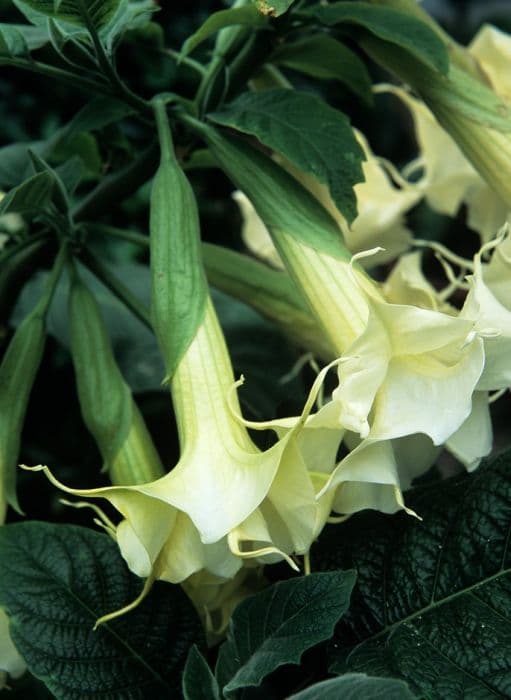Bell pepper Capsicum annuum 'Lemon Dream'

ABOUT
The Lemon Dream is a vibrant and colorful variety of pepper plant that is known for its eye-catching fruits. The pepper itself is the star of the show, displaying a bright lemon-yellow color as it matures. These peppers are elongated and slender, with a smooth, glossy skin that gives them an appealing look. The peppers start off green on the plant and gradually change to their namesake lemon yellow as they ripen. The plant has a bushy growth habit, with lush green leaves that are typical for pepper plants – they have a slightly wrinkled appearance with a dark green color and are oval-shaped with a pointed end. The foliage provides a striking backdrop for the peppers, creating a nice contrast with the sunny hues of the fruit. The stems of the plant are sturdy and may have a light green to a darker green hue. Sprouting from the stems are the flowers that precede the peppers – these blooms are often white and star-shaped. They are small in size but significant in their role, as they are the forerunners of the peppers that will develop. Overall, the Lemon Dream pepper plant has a fresh and cheerful presence with its contrasting greens and bright yellow fruits, and its balanced, compact growth combined with the vibrant appearance of its produce makes it popular among garden enthusiasts and those looking to add a pop of color to their vegetable patch or container garden.
About this plant
 Names
NamesFamily
Solanaceae
Synonyms
Lemon Dream Pepper, Ornamental Chili Pepper, Sweet Pepper 'Lemon Dream'
Common names
Capsicum annuum 'Lemon Dream'.
 Toxicity
ToxicityTo humans
Bell pepper 'Lemon Dream' is generally considered non-toxic to humans. However, as with any pepper variety, sensitive individuals may experience mild digestive distress if they consume a large quantity or are not accustomed to spicy foods. Additionally, the capsaicin in peppers can cause a burning sensation if it comes into contact with the skin, eyes, or mucous membranes.
To pets
Bell pepper 'Lemon Dream' is not considered highly toxic to pets. While the flesh of the pepper itself is not harmful and may be safely consumed in small amounts, the seeds can cause gastrointestinal upset in some pets. Additionally, the capsaicin that gives peppers their heat can be irritating to a pet's digestive system, mouth, or eyes if ingested in large quantities. It's generally advisable to offer bell peppers to pets in moderation, if at all, and to avoid the seeds and stem.
 Characteristics
CharacteristicsLife cycle
Annuals
Foliage type
Deciduous
Color of leaves
Green
Flower color
White
Height
1-2 feet (30-60 cm)
Spread
1-2 feet (30-60 cm)
Plant type
Herb
Hardiness zones
9
Native area
Americas
Benefits
 General Benefits
General Benefits- Ornamental value: 'Lemon Dream' adds visual interest to gardens and landscapes with its bright yellow fruits and vibrant green foliage.
- Edible fruits: The peppers are edible, providing a fresh, tangy flavor to a variety of culinary dishes.
- Easy to grow: This variety of pepper is considered easy to cultivate, making it suitable for gardeners of all skill levels.
- Pest resistance: Capsicum annuum varieties are known for their resistance to certain garden pests, reducing the need for chemical pesticides.
- Compact growth: Its compact size makes it ideal for container gardening or small garden spaces.
- Attracts pollinators: The flowers can attract beneficial insects such as bees to the garden, enhancing pollination of other plants.
 Medical Properties
Medical Properties- Capaicin Content: Contains capsaicin, which has been shown to provide pain relief by reducing the intensity of pain signals sent through the body.
- Antioxidants: Rich in antioxidants, including vitamin C and carotenoids, which may help reduce oxidative stress and inflammation.
- Gastrointestinal Health: May aid in digestion and help prevent stomach ulcers by reducing the bacterial growth of H. pylori and increasing blood flow to the stomach lining.
- Weight Management: Capsaicin has been found to increase energy expenditure and lipid oxidation, which could assist with weight loss efforts.
- Cardiovascular Benefits: The high flavonoid and vitamin content may contribute to cardiovascular health by improving blood vessel function and reducing blood pressure.
- Immune Support: The high levels of vitamin C can help support immune function.
 Air-purifying Qualities
Air-purifying QualitiesThis plant is not specifically known for air purifying qualities.
 Other Uses
Other Uses- Natural Insect Repellant: 'Lemon Dream' peppers can be crushed and mixed with water to create a natural insect repellent spray, thanks to the capsaicin that can deter many types of insects.
- Colorful Landscaping: With their vibrant yellow fruits, these plants can be used to add a pop of color to garden beds or landscapes.
- Culinary Coloring: The bright yellow of 'Lemon Dream' peppers can be used to naturally color foods, such as rice dishes or pastas, without adding artificial dyes.
- Arts and Crafts: Dried or fresh, these peppers can be used in wreaths or other decorative items, adding a rustic or country feel to the design.
- Education and Research: These plants can be used in educational settings to teach about plant growth, photosynthesis, and the life cycle of plants.
- Photography Prop: The attractive appearance of 'Lemon Dream' peppers makes them an excellent subject for still life or garden photography.
- Homemade Potpourri: Dried 'Lemon Dream' peppers can be added to potpourri mixes to contribute to the color variety and aesthetic appeal.
- Cooking Competitions: Their unique color and mild heat make them a favorite in chili or salsa competitions for those looking to add a twist to traditional recipes.
- Fruit Leathers: Dehydrated 'Lemon Dream' peppers can be pureed and made into spicy fruit leathers for a tangy snack.
- Seed Harvesting: Gardeners can harvest seeds from these peppers to grow new plants or to exchange with others as part of seed swap activities.
Interesting Facts
 Feng Shui
Feng ShuiThe Bell Pepper is not used in Feng Shui practice.
 Zodiac Sign Compitability
Zodiac Sign CompitabilityThe Bell Pepper is not used in astrology practice.
 Plant Symbolism
Plant Symbolism- Passion: The capsicum, also known as chili pepper or bell pepper, has been a symbol of passion and warmth, reflecting the intense flavor and heat that some varieties of the pepper can bring to dishes.
- Protection: In some cultures, chili peppers are thought to ward off evil spirits and are used in rituals for protection.
- Vitality: Their bright colors and spicy taste make chili peppers a symbol of energy and life force.
- Healing: Many believe in the medicinal properties of capsicum, symbolizing healing especially in terms of pain relief and improving circulation.
- Transformation: The growth process of chili peppers from a small flower to a brightly colored fruit symbolizes growth and transformation.
 Water
WaterBell peppers, such as 'Lemon Dream', should be watered deeply and thoroughly. The soil should be kept evenly moist but not soggy. In general, watering once a week with about 1 to 2 gallons of water per plant is sufficient, but this can vary based on climate, soil type, and plant size. During hot, dry periods, more frequent watering may be necessary. It's best to water the plants early in the morning to allow the foliage to dry out during the day, reducing the risk of disease.
 Light
LightBell peppers, including the 'Lemon Dream' variety, thrive in full sun. They require at least 6 to 8 hours of direct sunlight per day. The best spot for these plants is an area where they can receive unobstructed sunlight throughout the day, ensuring they grow healthy and produce a good harvest.
 Temperature
TemperatureBell peppers like 'Lemon Dream' prefer warm temperatures and grow best when daytime temperatures are between 70°F and 85°F. They can survive minimum temperatures of about 60°F and maximum temperatures of around 95°F. However, prolonged exposure to temperatures outside this range can stress the plant and affect fruit production.
 Pruning
PruningPruning bell peppers, including 'Lemon Dream', is not strictly necessary but can help maintain plant shape and encourage air circulation. If you choose to prune, do so by removing any dead or diseased branches and any small or malformed peppers to focus the plant’s energy on producing larger, healthier fruits. Pruning is best done early in the growing season or when necessary to reshape the plant.
 Cleaning
CleaningAs needed
 Soil
SoilBell peppers like 'Lemon Dream' thrive in well-draining, loamy soil enriched with compost and a balanced fertilizer. A slightly acidic to neutral pH between 6.0 and 6.8 is ideal to foster healthy growth and fruit development.
 Repotting
RepottingBell peppers like 'Lemon Dream' should be repotted annually, or when they outgrow their current container, to ensure continued growth and to replenish nutrients in the soil.
 Humidity & Misting
Humidity & MistingBell peppers like 'Lemon Dream' prefer a moderate humidity level, ideally between 40-70%, to thrive and produce a healthy crop of peppers.
 Suitable locations
Suitable locationsIndoor
Give 'Lemon Dream' bell pepper bright light and warmth indoors.
Outdoor
Place 'Lemon Dream' bell pepper in full sun, sheltered from strong winds.
Hardiness zone
9-11 USDA
 Life cycle
Life cycleCapsicum annuum 'Lemon Dream', commonly known as lemon dream pepper, begins its life cycle as a seed, which, when sown in warm, fertile soil, germinates within 1-3 weeks depending on conditions. The seedling stage follows, where the plant develops its first true leaves and gradually matures into a vegetative stage characterized by a sturdy stem and a leafy structure. During the flowering stage, the plant produces small, white flowers that are pollinated either by insects or through self-pollination, leading to the development of the fruit. The fruiting stage sees initially green peppers that mature into a bright lemon-yellow color, indicating they are ripe and ready for harvesting. After fruiting, if the plant is an annual variety in a temperate climate, it will complete its life cycle and die after seeds are set or conditions become unfavorable. In warmer climates or with proper care, pepper plants may survive multiple seasons, though they are typically grown as annuals.
 Propogation
PropogationPropogation time
Spring-Early Summer
The most popular method of propagation for the Capsicum annuum 'Lemon Dream', commonly known as the Sweet Pepper, is by seed. Ideally, propagation by seed should be started indoors about 8-10 weeks before the last expected frost date in an area. Seeds are sown in a sterile seed starting mix, lightly covered with soil, and kept moist at a temperature of 70 to 80 degrees Fahrenheit (21 to 27 degrees Celsius). The seed trays should be placed in a bright area but not in direct sunlight until germination, which typically occurs within 7-14 days. Once the seedlings have developed their first true leaves, they can be transplanted into individual pots and eventually moved outdoors after the risk of frost has passed and they have been properly hardened off.



![Calibrachoa [Callie Mango]](/_next/image?url=https%3A%2F%2Fplants-admin.emdemapps.com%2Fimages%2Fplants%2F%2Fimages%2F604b6514b1579.png&w=640&q=75)





